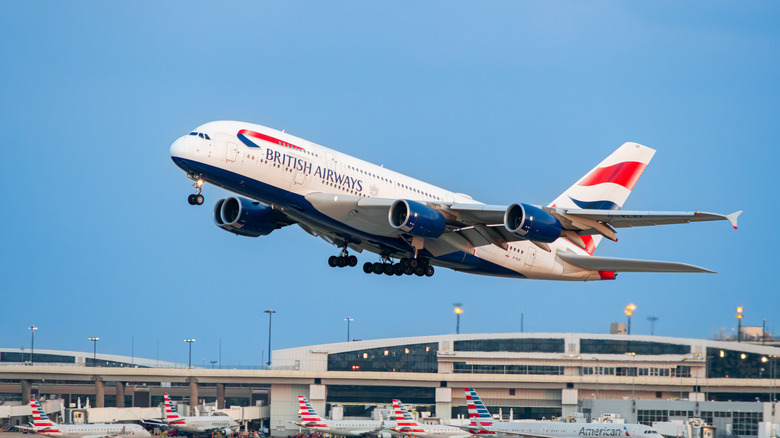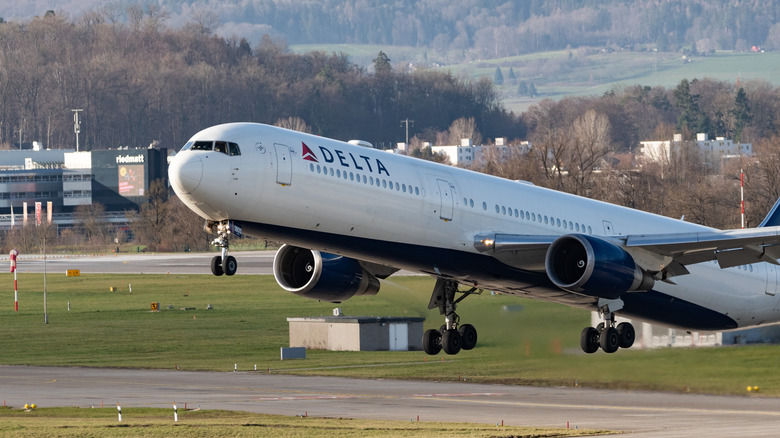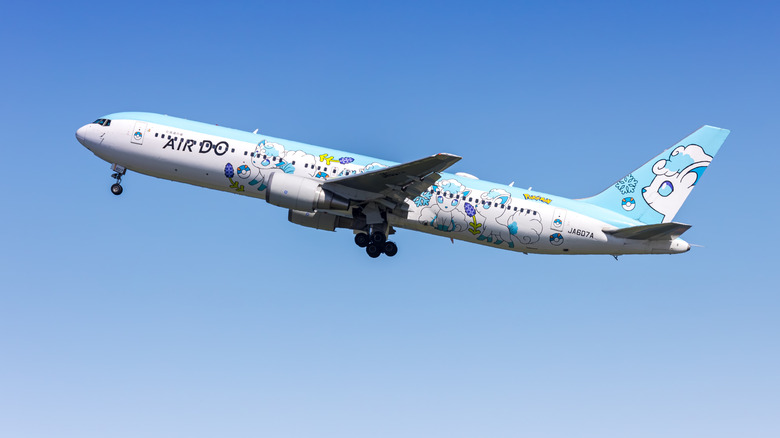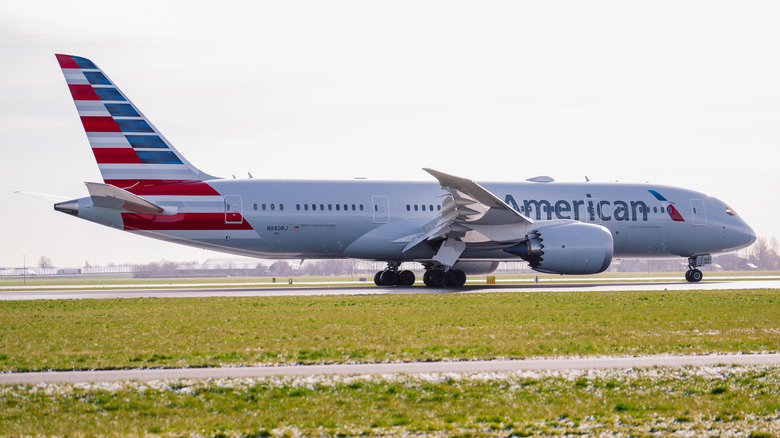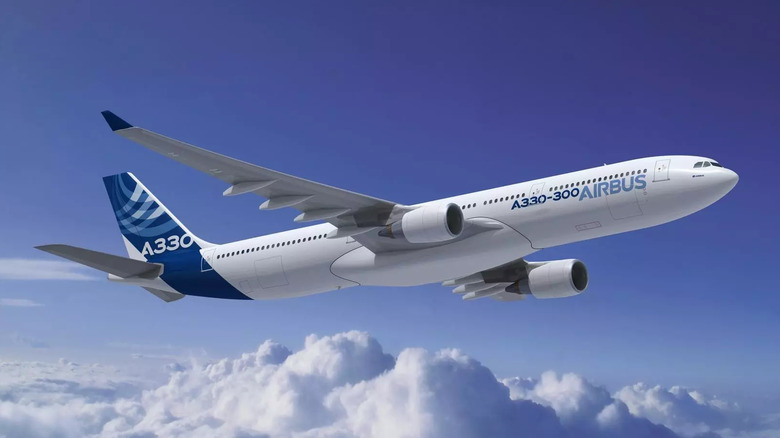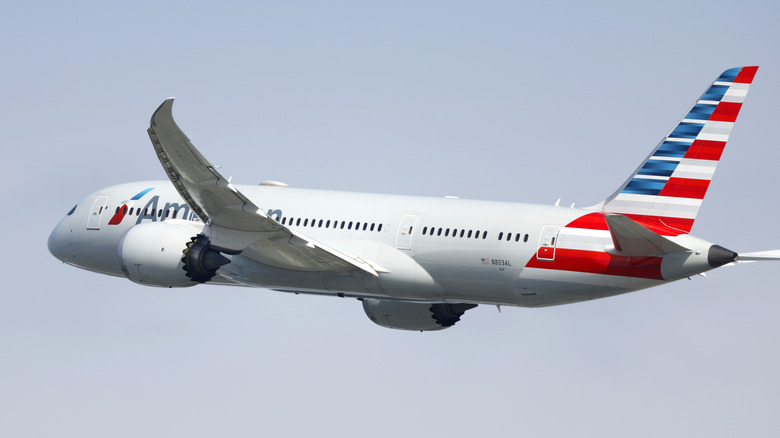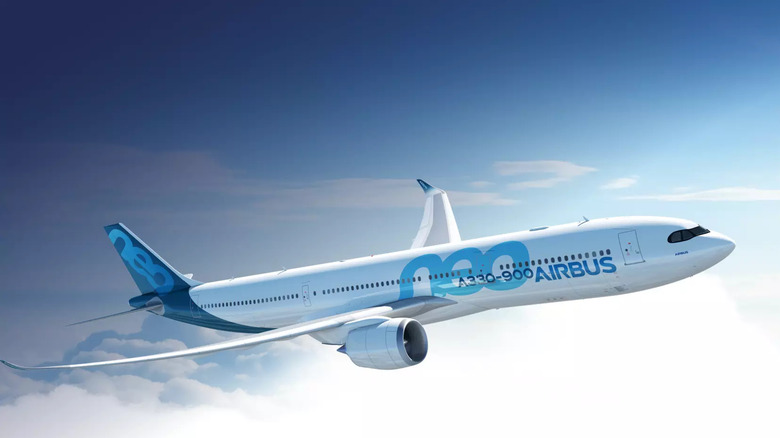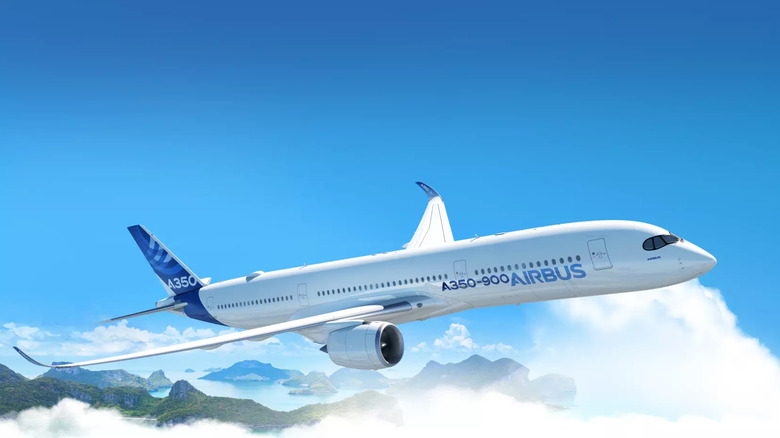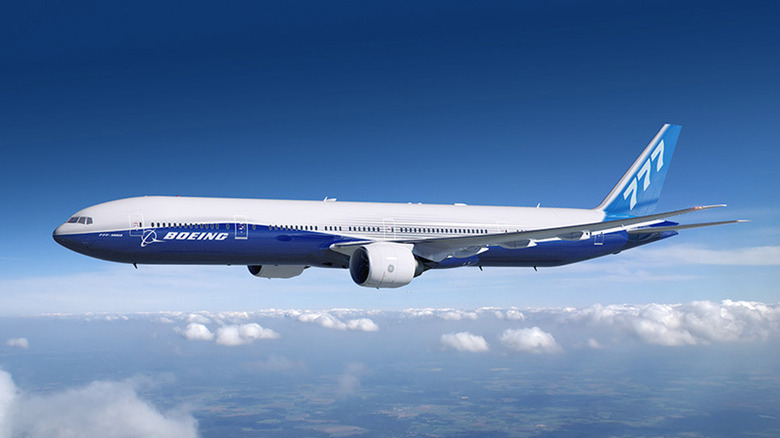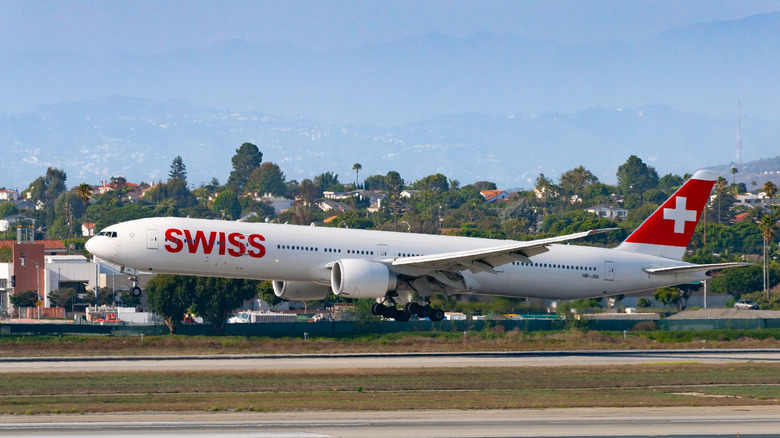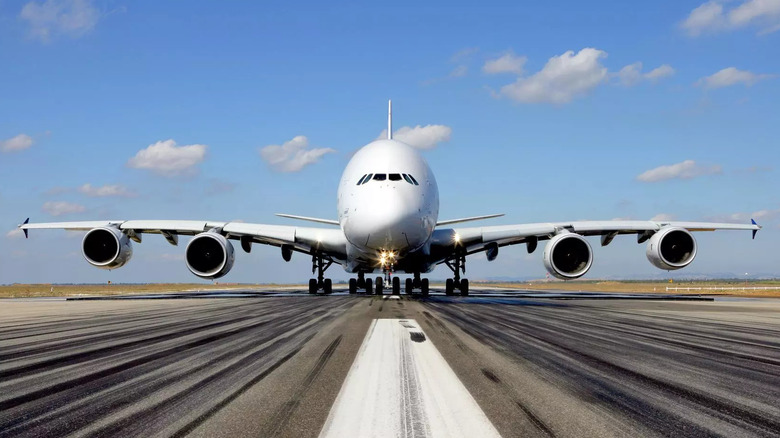10 Popular Wide-Body Passenger Planes Ranked From Cheapest To Most Expensive
Planes have become the default way for most people to travel across the country, or between countries, and airlines use a nearly unimaginable variety of them to ferry us from place to place. Some are designed to be fuel efficient at short range, others are designed to carry the maximum number of passengers, and still others are made to simply go the distance. Among all those types and classifications, a "widebody" jet is simply a jet with two aisles to walk up and down on.
The price we've chosen is the "list price," which is before discounts are given to airlines. The reason for this is that airlines almost never pay list price or "config price" for a model, as tier bulk orders and loyalty history get them a discount. For instance, Emirates may get a solid 20% discount with Airbus, given their order history and size, so for them an A330-300 may only be $160 million, while a smaller airline like Qantas may have to pay $180 million per unit. Keeping it to list prices makes it simple. Additionally, for a plane to be classified as "popular" we used one simple metric — does it or did it make up a large chunk of an airline fleet? If yes, it's on the list. So, with that in mind, here are 10 of the most popular wide-body planes used for passenger transport.
Boeing 767-400ER – $173 million
The first plane on our list is the Boeing 767-400ER, (the ER stands for "extended range"). Though the the Boeing 767 jet platform was introduced as far back as 1982, the 400ER version of the platform came into service in early 2000 when Continental Airlines (now merged with United) ordered 26 of them. The last reported list price for the 767-400ER was $173 million in 2008. When they were available to be specced, the 767-400ER came with a Rockwell-Collins avionic systems suite, and was powered by either twin CF6-80C2B7F1 Turbofans from General Electric, or by dual Pratt and Whitney PW4000s, which could push the plane to its maximum cruising speed of 567.3 mph.
The 767-400ER had an impressive service ceiling of 43,000 feet, which it could climb to at a speed of 2,500 feet per minute (fpm), and had a fuel economy of 0.23 nautical miles per gallon. Other important features on the 767-400ER were its range of 6,473 miles, takeoff distance of 9,501 feet, and landing distance of 7,001 feet. The two main customers of the 767-400ER were United and Delta airlines, and, incidentally, the sixth 767-400ER delivered to Delta was actually Delta's 100th plane based on the 767 platform — a true workhorse. If the plane were to have only economy, a total of 375 people could have been ferried from place to place — but for obvious reasons this was not done. Boeing removed the 400ER from its lists in 2014.
Boeing 767-300ER – $217.9 million
The Boeing 767-300ER was built on the same 767 platform as the 400ER above. Debuting in 1982, the platform was upgraded in 1984 to the 767-200, and was stretched to the 767-300ER in 1988. "Stretched" in the aviation sense simply means that "plugs" are added to the end of the fuselage to make the aircraft longer than it was at launch. On the 300ER, this meant that it was 180.25 feet long, versus the 767-200, which was about 20 feet shorter at 159.12 feet. This stretching added significant capacity: the 767-200 could fit 255 economy seats (limited by the FAA), but the 767-300ER, though only 20 feet longer, could fit in a maximum of 290 (FAA limited) economy class seats. Like most other production units on the 767 platform, the 300ER came with a Rockwell-Collins avionics system, and its last reported list price was $217.9 million.
If you're wondering why the 300ER is more expensive than the 400ER, it's because airlines could buy a new 300ER as recently as 2019, whereas 400ER orders were discontinued in 2014. Another noteworthy fact was that the 300ER had a better range and climb rate than the 400ER, at 6,876 miles and 3,000 fpm respectively. Power for the 767-300ER came from one of three engine families: The General Electric CF6s, Pratt and Whitney PW4060s, or the Rolls-Royce RB211s, producing 60,600 pounds of thrust, which could get the plane up to a maximum cruising speed of 559.2 mph.
Boeing 787-8 Dreamliner – $248.3 million
The next plane we have is the 787-8 Dreamliner, widely agreed to be the best-selling widebody passenger airliner of all time. According to Boeing, the 787-8 has carried a billion people around the world since it was introduced 14 years ago, nets airlines a one quarter reduction in fuel use, and has "unlocked" 425 new nonstop routes because of its range and fuel economy combined. In a standard two-class layout, the $248.3 million 787-8 can accommodate 248 passengers, and can fly 8,407 miles in each flight. Interestingly, the 787-8 is wider than it is long, with a total length of 187 feet and total wingspan of 196.85 feet.
Power comes from either twin GEnx-1B engines or from Rolls-Royce Trent 1000s, making 64,000 pounds of thrust, which can push this behemoth to its max cruising speed of 587 mph and give it a takeoff distance of 4,986 feet — less than the 767-400ER. The 787-8 has an MTOW, which stands for maximum takeoff weight, of a whopping 502,494 pounds, and can carry 33,528 gallons of fuel, which makes the 8,400 mile range all the more impressive. Most major carriers around the world operate the 787-8, including Qatar Airways, Etihad, Emirates, Air India, Air Canada, and more. Stateside, United operates 2,937 flights a month on the 787 platform, and American follows closely at 2,748 a month; though it should be noted that these figures are for all variants of the 787, not just the 787-8.
Airbus A330-300 – $264.2 million
For those of us who love a quiet plane ride, the Airbus A330 passenger jet is the best choice to fly on, as many airlines (and Airbus itself) say that it has one of the quietest cabins in the industry. Capitalizing on this, Airbus has outfitted some of its A330-300s, like those for Air Asia, with a special "noise isolation economy zone" located behind the business class seating area that's supposed to be quieter than the regular economy zones — though one screaming baby can supposedly change all that. Notably, the A330-300 is the oldest widebody aircraft from Airbus still being produced today, and with good reason. It's decently affordable, especially in bulk orders, has an amazing range, and can be configured for any variety of seating plans that the operator desires.
Currently, the A330-300 carries a list price of $264.2 million, for which you get an aircraft that can seat a maximum of 440 passengers, has a service range of 7,307 miles, takeoff distance of 9,087 feet, landing distance of 5,675 feet, and a service ceiling of 41,100 feet. The Airbus A330 engines are currently two General Electric CF6 units that produce a not-insignificant 71,100 pounds of thrust, and that allow the A330-300 to cruise at a max speed of 540.5 mph. It is also one of the longer planes on this list, at 208 feet, 10 inches long, with an equally impressive wingspan of 197 feet, 10 inches.
Boeing 787-9 Dreamliner – $292.5 million
The 787-9's price tag of $292.5 million is so attractive that it probably ends up cannibalizing some market share from the $300-$350 million 777x range, also by Boeing — it's that good. It is based on the same platform as the 787-8 that we covered above, and is essentially a bigger, better version of the 787-8, which is the "entry" level variant to the 787 platform. The 787-9 however, comes with big upgrades to its technology suite, with components from Rockwell-Collins as well as Honeywell in the cockpit. The 787-9 also has the same engines as the 787-8, namely, two GEnx-1B units, or two Roll-Royce Trent 1000 turbofan units, though these make a lot more power, offering 71,000 pounds of thrust versus the 787-8's 64,000 pounds.
In addition, the 787-9 Dreamliner has a higher maximum cruising speed at 594 mph, making it one of the fastest commercial planes. It also has a slightly improved range of 8,705 miles, and a service ceiling of 43,100 feet, which it can reach at a climb rate of 3,000 fpm. The 787-9 is also significantly longer than its smaller sibling, at 206 feet long, though it has the same wingspan of 197 feet. Currently, the 787-9 Dreamliner is operated by major names like KLM, British Airways, Lufthansa, ANA, Westjet, Japan Airlines, Thai Airways, and United — most of which are part of the Star Alliance.
Airbus A330-900neo – $296.4 million
The Airbus A330-900neo is considered by many to be the main competitor to the 787-9 today, so it's only fitting that it's the next plane on our list. With a list price of $296.4 million, this plane was introduced in 2015, a year after the 787 from Boeing, and manufactured in France. The A330-900 was a major upgrade over the previous generation, bringing about several improvements, the most important of which was a seating capacity upgrade to 465 seats in a one-class layout. Other notable improvements were to the range, which was been increased to 8,458 miles, electronically dimming windows, and a 25% fuel consumption reduction when compared to the previous generation A330-200ER.
In addition, the carbon dioxide emissions were also reduced by one quarter when compared to previous generation A330-platform based models. As with other Airbus A330 models, the 900neo was powered by twin Rolls-Royce Trent 7000 engines, essentially scaled-up, more efficient versions of the older Trent 1000s that were used on other, larger models. It had a service ceiling of 41,450 feet, and could reach there after running through about 9,842 feet of runway, which was its takeoff distance. Landing distance was slightly better, at 5,577 feet, which is a little more than a mile long. You might be interested to learn that Delta Airlines is the largest and most prominent operator of the A330-900 neo, with 24 units in its fleet.
Airbus A350-900 – $308 million
The A350 platform is in essence a scaled up version of the A330 platform, and one of the safest passenger planes in the world. The particular model that we've chosen for this list is the $308 million A350-900, currently in use by Delta, United, Air France, Singapore Airlines, Emirates, Qatar Airways, Air India, Cathay Pacific, Etihad, Thai Airways, and many more global heavyweights of the industry. The A350-900 is among the only planes that can fly a three-class layout of up to 350 passengers or more, over a distance of 11,185 miles, while being 25% more efficient on both fuel and emissions when compared to previous generation planes.
The A350-900 can fly long-haul routes like San Francisco to Singapore City, Los Angeles to London, and London to Perth in one trip, without any layovers — though whether or not we humans can take that trip is a different issue. Airbus sticks to Rolls-Royce engines as usual for their A350 range; specifically using two Rolls-Royce Trent XWB-84 engines that make a colossal 87,000 pounds of thrust. Airbus has really gone all-in on the A350 range, making it the quietest cabin of any of their planes, and have even given it features like mood lighting with more than 16 million different colors. In addition, it can seat up to 440 passengers in a single class layout, though the typical three-class seating capacity is between 330 and 352 people.
Boeing 777-200LR – $346.9 million
Our number three entry is the Boeing 777-200LR, which stands for "long range". As the name suggests, this is an endurance model, with a maximum takeoff weight of 765,993, capable of carrying 47,890 gallons of fuel and with a nonstop flight range of 9,844 miles. It is truly gargantuan at 209 feet, 1 inch long, standing 61 feet, 1 inch above the ground, and with a truly colossal wingspan of 212 feet, 7 inches. Power for this behemoth comes from two General Electric GE90x engines, which are currently the GE90-115BL to be exact, producing 115,300 pounds of thrust — which ties the 777-200LR with the 777-300ER for highest engine thrust on our list.
Incidentally, the engines that power the 777-200LR, 777-300ER, and 777 freighter are officially the most powerful jet engines ever built, while maintaining remarkably efficiency. These massive engines allow for the 777-200LR to climb to its service ceiling of 43,100 feet at a climb rate of 2,500 fpm and to cruise at a maximum speed of 587 mph. The 777-200LR is also one of the heaviest planes to exist, with a maximum takeoff weight rating of 765,993 pounds, of which a substantial portion comes from the fuel. Today, the 777-200LR is used by Emirates, Qatar Airways, Ethiopian, Turkmenistan Air, Air India, and many other long-haul players.
Boeing 777-300ER – $375.5 million
A step up from the previous 777-200 Long Range, the Boeing 777-300ER is one of the most expensive widebody passenger jets ever sold. Coming in at an eye-watering $375.5 million, it features the latest in avionics technology from Honeywell, including a feature called "electronic checklists" that can be customized to the airline's liking, and can check off items automatically based on information from the flight deck. It is also considered one of the best looking planes around, from a design perspective, having been given the Industrial Design Excellence Award by the Industrial Designers Society of America.
Since the 777-300ER is powered by the same GE90-115BL engines as the 777-200LR, it makes the same thrust; a mind-boggling 115,300 pounds, though it does have a slightly worse fuel consumption at 0.16 nautical miles per gallon, versus the 200LR's 0.18 nautical miles per gallon. Another standout feature on the 777-300ER is that it has the widest cabin of any aircraft ever produced, and any aircraft currently planned, so airline customers have a lot more leeway when planning their cabin configurations. The cabin is so wide that in economy seating sections, airlines can opt for a 10-abreast seating pattern, which would mean 3-4-3 seats, where the dashes indicate an aisle. With features like that it is no wonder that super-premium carriers like Emirates, Thai Airways, Qatar Airways, Singapore Airlines, and the Star Alliance members were quick to place orders for this jet.
Airbus A380 – $445 million
If the 747 was the queen of the skies, then the $445 million Airbus A380 is the king, with a number of standout features. It is the largest passenger plane ever built, and the only full-length double decker plane in the world. Other planes, such as the Boeing 747 with its hump, only have partial upper decks. In a full economy one-class layout, the A380 could accommodate up to 850 passengers, and is also the only passenger aircraft to offer more than 500 seats in a multi-class cabin configuration.
When launched it featured revolutionary materials in the industry, such as carbon-fiber reinforced polymers (CFRPs) and aluminum-lithium (al-li) alloys that were light, rigid, strong, and most importantly, corrosion resistant. Power for this gargantuan airplane comes from the Rolls-Royce Trent XWB 900 engines, which made their debut flight on an A380 testbed aircraft. Later, airlines could also optionally choose to power their A380s with twin Engine Alliance GP7270 units, which could make 81,500 pounds of thrust and gave the plane a range of 9,206 miles. Imagine: a plane that can carry an entire school's worth of people from Los Angeles to Sydney (7,494 miles) and still have almost 2,000 miles of range leftover. All in all, it's a truly amazing, versatile, much-loved aircraft, and it is sad that it is no longer in production.
